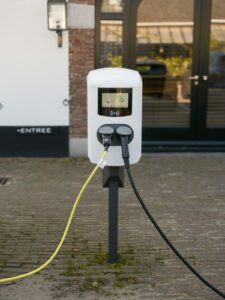
Home / EV Charging News / Embracing the EV Wave: Overcoming the Challenges of Fleet Optimization
There’s no doubt about it anymore: Electric vehicles are the future. By 2030, experts project the electric vehicle (EV) market will quadruple, reaching a value of $208.95 billion dollars.
Electrification will no longer be a trendy buzzword or tax incentive — it will be the norm. Any business that hasn’t gone EV by then will have already fallen lightyears behind their competitors.
Going electric does carry a hefty upfront cost, but the expense of not electrifying is far worse. Gas prices will continue to rise, and maintenance on non-electric vehicles will also inflate. Although you may pay less for insurance or auto loans, the actual cost of ownership will far exceed the value of a non-electric model.
But where do you even begin going electric? It isn’t always easy despite the vast amount of articles published about fleet electrification. This post is designed to help you learn everything you need to know about electric vehicles and integrating them into your business.
Electric fleets can lower operating and maintenance costs, qualify you for tax bonuses and decrease your company’s carbon footprint. They also offer improved safety and can boost employee and customer satisfaction.
The proliferation of electric vehicles is unavoidable, which means integration and expansion should be at the top of every fleet owner’s task list. The sooner a company makes the transition, the easier it will be for them to capitalize on the money-saving technologies rolling out across the sector.
Although people are aware of the importance of modernizing their fleets with electric vehicles, they still aren’t entirely sure where to begin. The largest struggle seems to be in the lack of streamlined processes.
Vehicle acquisition, installation and charging procedures all have a major influence on workflow. Driving constraints due to reduced mileage may also play a factor in how easily a company can electrify their fleet.
Is there really a one-size-fits-all solution out there? Possibly. Technology is helping fleet managers optimize and centralize all of their EV equipment. The key is identifying the right solution for each business’s budget and size.
One of the biggest challenges that EV fleets face is accessing the grid when they need it most. From a technical standpoint, there is more than enough power to go around, but charging times can negatively impact performance.
Without your own ports, charging stations extend workers’ hours and can disrupt routes. Extending employees’ hours and infringing on delivery times demands a quicker solution. The best way to do this is by bringing the grid to you.
You can charge fleet vehicles using the right EV charging station or so called ESVE. With your own docks, it’s possible to charge vehicles whenever you need to. Optimization with a management controller lets you reduce costs and save time in the process.
While EV fleets save money on fuel, they can become equally expensive with added utility rates. Business owners may struggle to choose between electrification and scaling down their fleets to offset the costs.
A major concern for businesses who electrify is paying for added energy expenses. Cyber Switching CEO Chuck Renyolds explains why peak demand charges will likely rise as electrification expands. Because charging during periods of high use result in greater costs, businesses that aren’t optimized for electric fleets will lose thousands of dollars in increased utility bills.
A system that streamlines charging and optimizes power usage can help mitigate this obstacle. By being able to connect multiple vehicles to a single line, fleets get the energy they need without paying for accessibility.
Introducing electric vehicles into the workplace requires onboarding and training, even for experienced drivers. Charging practices and routines will ultimately impact how drivers perform; without adequate resources or the right equipment, a company can easily lose hundreds of hours a year in productivity.
Hiring qualified technicians to cover the training process is a good way to avoid initial roadblocks. Drivers should also have handouts provided for them to review whenever they need help; factors that may not have influenced vehicle performance before now require specialized attention.
For example, driving an electric vehicle in the summer can decrease driving range by up to 17%. Mileage may also be impacted by routes, vehicle loads and idle times. Controlling these factors — and adapting to external circumstances — requires ongoing collaboration between fleet managers and drivers.
Planning ahead with ongoing training and support helps businesses improve driver performance while getting the greatest ROI.
Small to mid-size fleets can benefit from a management system like Cyber Switching EVMC (Electric Vehicle Management Controller). The on-demand management controller allows you to connect up to four EVSEs to a single power line; this helps lower energy expenses without compromising performance and save tens of thousands on electrical upgrades.
The right management and EVSE can also save workers vital hours on the job; with the EVMC, companies can save up to 300 hours a year in productivity. A company can charge fleet vehicles without losing business thanks to greater accessibility and optimized power distribution.
Whether you are optimizing an existing fleet or thinking of buying your first electric vehicle, the right equipment makes a world of difference. By choosing the best management controller and EVSE, you can guarantee your fleet will be able to handle whatever comes next in fleet technology.
$2,890.00 Original price was: $2,890.00.$2,790.00Current price is: $2,790.00.
$3,950.00 Original price was: $3,950.00.$3,450.00Current price is: $3,450.00.
$1,650.00 Original price was: $1,650.00.$1,590.00Current price is: $1,590.00.
$2,290.00 Original price was: $2,290.00.$2,150.00Current price is: $2,150.00.
$1,290.00 Original price was: $1,290.00.$799.00Current price is: $799.00.

Your Power Management Partner for Over 25 Years Future Generations Depend on Our Decisions Today ™
2024 © All rights reserved by CyberSwitching